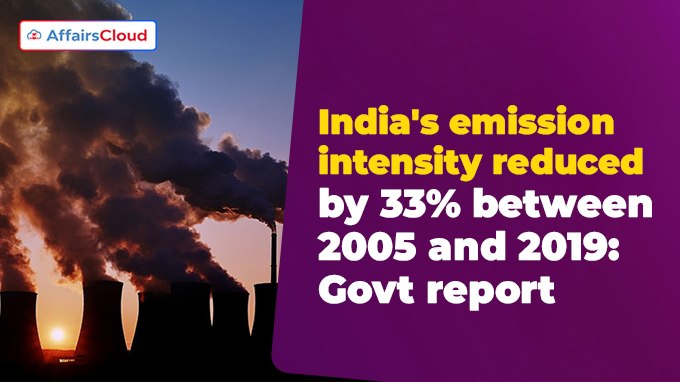 According to a Government report titled ‘The Third National Communication to the United Nations Framework Convention on Climate Change’, India reduced its Gross Domestic Product (GDP) emission intensity by 33% between 2005 and 2019. This was 11 years ahead of the target.
According to a Government report titled ‘The Third National Communication to the United Nations Framework Convention on Climate Change’, India reduced its Gross Domestic Product (GDP) emission intensity by 33% between 2005 and 2019. This was 11 years ahead of the target.
- India’s average rate of emission reduction increased from 1.5% annually during 2014 – 2016 to 3% annually from 2016 – 2019. This is the fastest recorded rate of reduction so far across any country.
- India created an additional carbon sink of 1.97 Billion tonnes of Carbon Dioxide (CO2) equivalent during this period.
- However, India’s total emissions (including the Land Use, Land-Use Change and Forestry sector) have increased by 4.56% with respect to 2016.
Note:
i.The emission intensity of the economy refers to the total amount of greenhouse gases emitted for every unit increase of gross domestic product (GDP). It is different from absolute emissions.
ii.This report will be submitted to United Nations Framework Convention on Climate Change(UNFCCC) during the 28th Conference of the Parties (COP28) being in Dubai, United Arab Emirates (UAE) from November 30 to December 12, 2023.
- The submission meets India’s obligation to provide information under the Convention and the Paris Agreement.
Key Reason behind this Decrease:
The decrease in emissions is considered faster than expected. This is due to India’s increase in forested areas, schemes for promotion of non-fossil fuel-based energy, as well as targeting big polluters in the country (such as industrial, automotive and energy sectors).
Highlights:
i.The energy sector accounted for the maximum share of anthropogenic emissions (75.81%), followed by agriculture (13.44%), Industrial Process and Product Use (8.41%), and waste (2.34%).
ii.The LULUCF (Land Use, Land Use Change and Forestry) sector removed 4,85,472 Gigatonnes Of Carbon Dioxide Equivalent (Ggco2e) of emissions.
iii.Considering total emissions and removals, India’s net national emissions in 2019 were 26,46,556 GgCO2e (or 2.6 billion tonnes of CO2e).
iv.As per the report, India is on track to reach its commitments as part of the UNFCCC, to reduce emissions by 45% by 2030 compared to the 2005 level, and of creation of additional carbon sink of 2.5 to 3.0 billion tonnes through tree and forest cover by 2030.
v.Forests and trees amount to 24.56% of India’s land coverage, roughly one quarter, which equates to 80.73 million hectares.
vi.India has also seen a large increase in the promotion of green hydrogen energy
vii.Renewable energy accounts for 25.3% of all of India’s energy generation – this includes hydro, nuclear and fully renewable such as solar.
ix.Despite non-fossil capacity exceeding 40%, India generated 73% of power from coal in 2022-23.
- ‘New renewables,’ excluding hydropower, contributed 12%.
- The Central Electricity Agency anticipates coal’s share to drop to 55% and new renewables to reach 31% by 2030.
Recent Related News:
i.The International Energy Agency (IEA) released its ‘Gas 2023 Medium-Term Market Report‘. As per it, India’s natural gas demand is expected to rise by 4% in 2023 calendar year and will continue to increase at an average annual rate of about 8% till 2026.
ii.The United Nations Food and Agriculture Organization (FAO) released a report titled ‘The Impact of Disasters on Agriculture and Food Security 2023-Avoiding and reducing losses through investment in resilience‘ which is the first–ever global estimation of the impact of disasters on agricultural production focused on crops and livestock.
About United Arab Emirates (UAE)
Capital– Abu Dhabi
Currency– UAE Dirham
President– Mohammed bin Zayed Al Nahyan




